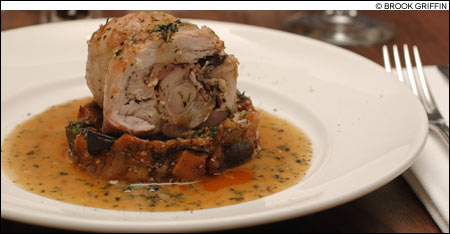The little space that used to be Torch has been taken over by Babak Bina and Azita Bina-Seibel of Lala Rokh. Contrary to reports, it’s been extensively remodeled and now fits 70 diners. The theme, as the name states, is wine, but the brother-sister team is as whimsical and fun with a wine bar as they are serious about Persian cuisine at Lala Rokh. The menu — initially reported to be mostly Italian, mostly small plates, and adjuncts to wine — has gotten rather innovative within those parameters. I don’t think anyone else in town serves monkfish in a coffee-based curry sauce, nor cocoa pasta with wild mushrooms. But Bin 26 Enoteca does.

FUN WITH FOOD: The Bin 26 ream is as fun with a wine bar as they are serious about Persian cuisine at Lala Rokh.
|
Let’s start with the wine list. It’s a loose-leaf book of about 26 pages, mostly organized by grape variety. But the owners have deliberately collected some very unusual grapes, and in the catch-all category you can’t always tell whether the grapes are red or white.
Four to five dozen wines are served by the glass, or in any of these four categories: a 100-milliliter taste, a 250-milliliter carafe (two typical glasses), a 500-milliliter carafe (two thirds of a bottle), or 750 milliliters (the standard wine bottle). The wine glasses vary for reds, whites, and sparklers. All but the last are oversize to gather more bouquet. (Real Champagne flutes — not those wide Champagne toasters — are narrow to show off the bubbles.)
I had my first taste of a sauvignon gris, the 2006 Cousiño-Macul ($12/$26/$44/$58). No, it wasn’t picked last month; it’s from Chile and is a spring vintage. The grape is a pink variety of sauvignon blanc from Bordeaux, but the wine has both the full body of white Graves and some of the tropical aromas of the New Zealand sauvignon blancs. It’s definitely a grape worth exploring in the Chilean version, and is reportedly being replanted in Bordeaux as well. A 2003 Chianti classico of Castello d’Albola ($7/$10/$28/$40) was smooth and rich, but somewhat monochromatic. This might be the result of that super-hot vintage, so it’s worth trying the riserva bottle. Our main bottle of wine, a Bourgogne passetoutgrains ($45) from Herbert Lignier, was an exotic combination of pinot noir and gamay, the grape of Beaujolais. This one leans toward the gamay, which makes it almost as light as Beaujolais, but also keeps the Beaujolais acidity and a little spiciness for fish dishes. The pinot noir contributes a little weight and vegetable nose, but I’ve had this blend in more Burgundian style.
Food starts with some old friends of wine: crusty Italian bread with holes and top-quality extra-virgin olive oil. Four of the appetizers are cheese platters ($6/each; $18/four). Our taleggio was a beautiful series of wedges criss-crossed on a dark tile, with walnuts, arugula, giant grapes, and thick honey — in fact, somewhat granulated and over-the-hill honey. But the cheese itself was fine, although not super ripe and smelly like some. A Tuscan pecorino, a firmer cheese, was cut into more elegant long wedges in the same presentation and had a nutty aged flavor with just a bit of sheepiness.
Charcuteries ($5/each; $16/four) include prosciutto, real Bolognese-style mortadella, fairly compelling Genoa salami, and — my favorite — speck, cut as thin as prosciutto but with plenty of smoke to it. We had all four, served with gherkins and horseradish sauce.
A white-bean soup ($9) was puréed with roasted red pepper to make it look like a thickened tomato soup. The first surprise was an effective dose of dill; the second was a pair of perfectly grilled shrimp as a kind of garnish. Soup in a big bowl loses heat, however, so some service adjustments are needed here. The carpaccio ($11) was one of the most beautiful and delicious I’ve ever had. The sliced raw beef was so uniformly pink it looked like a pool of raspberry sauce under an arugula-fennel salad.
Now about that coffee-curry monkfish ($23). The fish was chunked and wrapped in single leek leaves, adding only a subtle flavor. The side vegetables were a few carrots and quite a few slightly cooked cucumbers. But the sauce was brilliant. Coffee became an aromatic spice like cumin in an unconventional curry that didn’t taste like Indian food, but did taste spicy and complicated, without overwhelming a mild-flavored fish.
The cocoa tagliatelli ($14) was less exotic. Cocoa without sugar in pasta provides more color than flavor, creating a brown pasta that complements the woodsy appearance and flavor of wild mushrooms (mostly porcini with some shitake). A peppery undertone finished a flavor spectrum likely intended for old cabernet-based or Rhône wines.
Sea bass ($20) was one nicely filleted chunk, perhaps a New England tautog or black sea bass, served on barley risotto. Hangar steak ($21) is a nice version of the bistro specialty (like a thicker skirt steak from another part of the diaphragm), rare as ordered, with sautéed broccoli rabe.